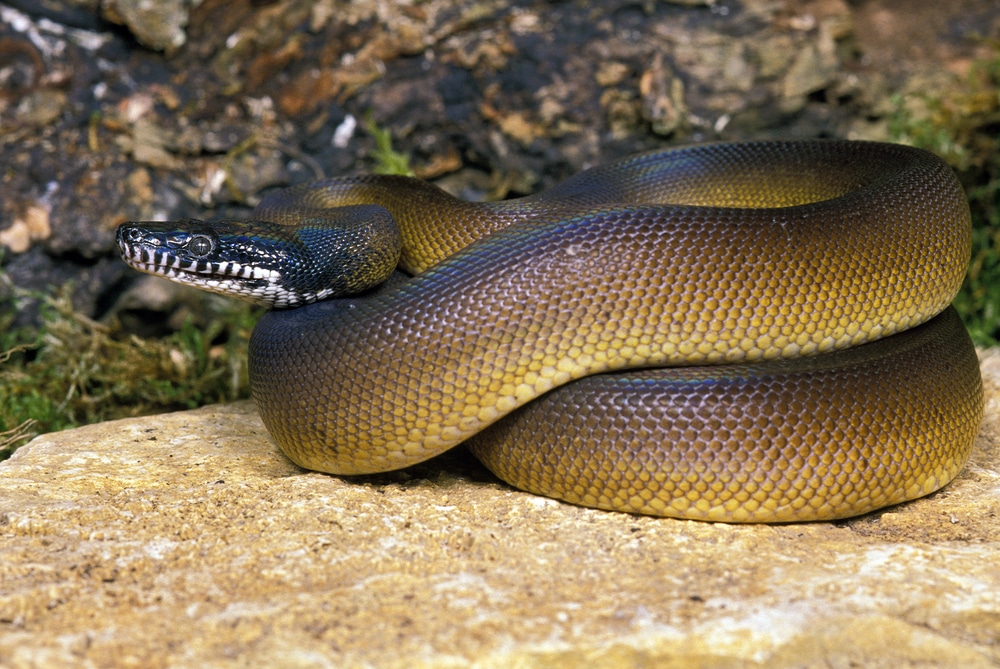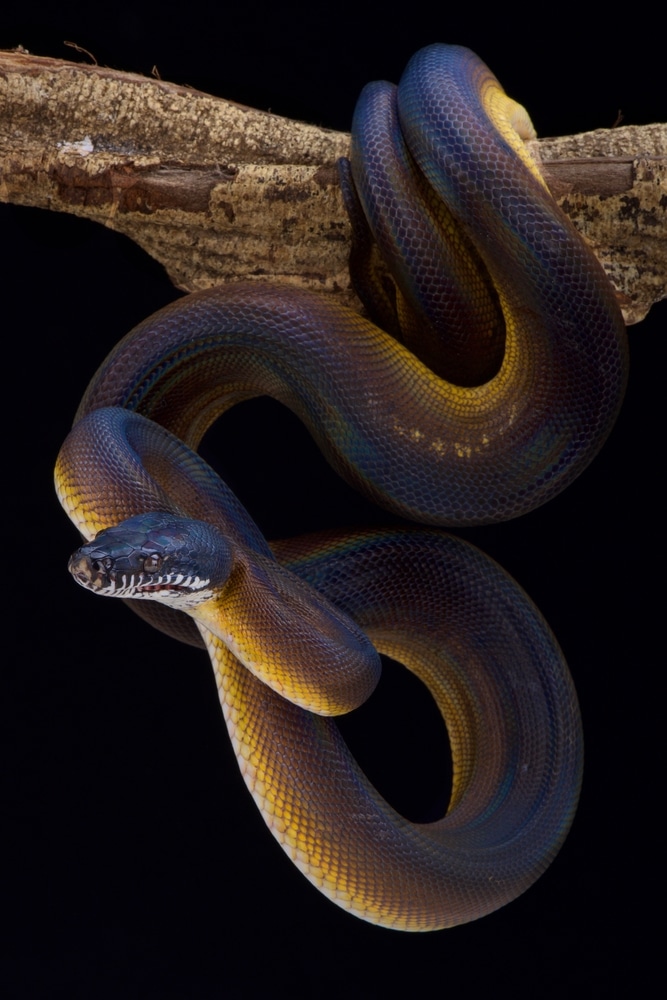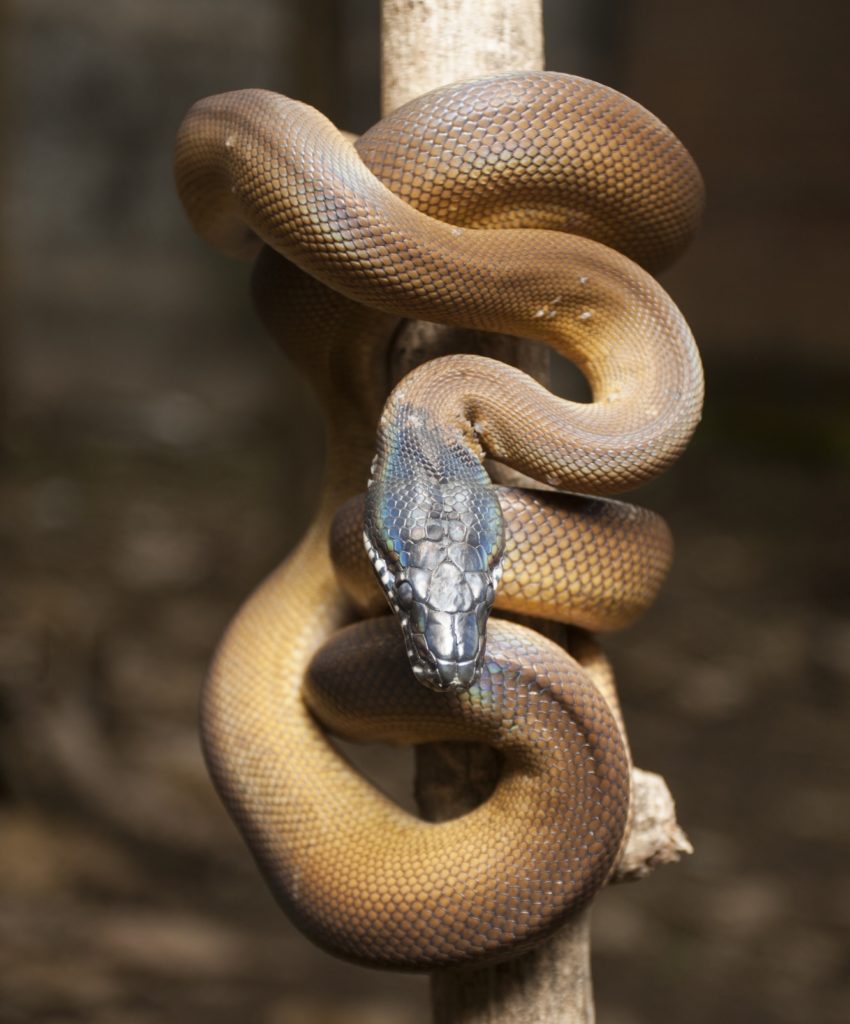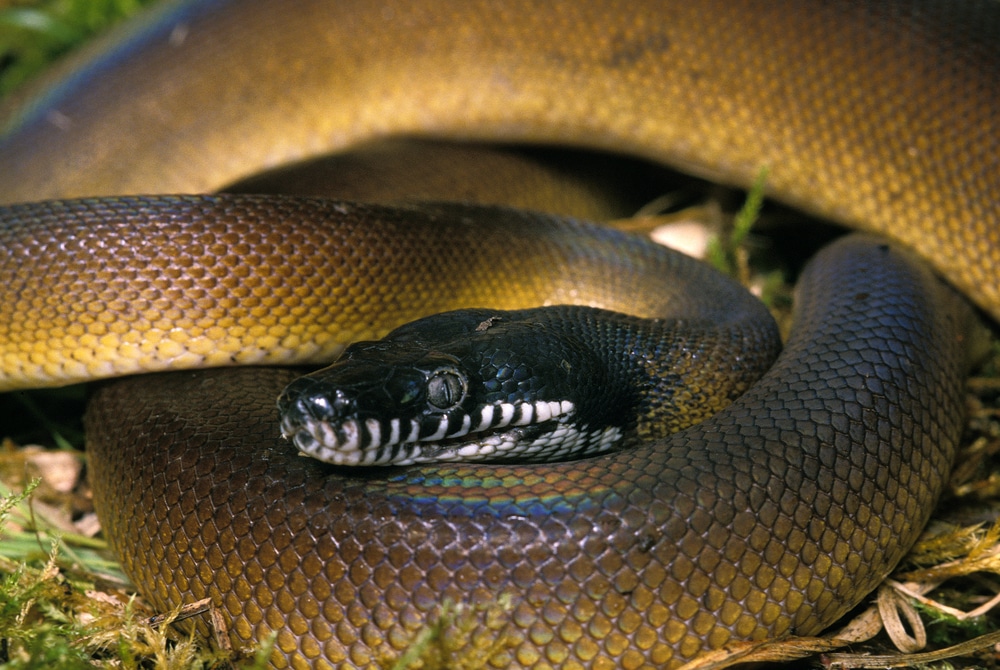White Lipped Pythons are hardy snakes that generally thrive and eat well. They are beautiful snakes with iridescent sides, a glossy black head and brilliant white lips which give them their name. Yet despite these strong points, not many herpers keep White-Lipped Pythons.
The White-Lipped Python is famed for being a foul-tempered reptile that will crawl across the room to bite. Many keepers more accustomed to docile snakes like Ball Pythons and Boa Constrictors are intimidated by the White-Lip’s reputation for being a chainsaw with scales.

But is the White-Lip’s bad reputation justified? Are they really surly beasts suited only for experienced keepers ready to shed blood for their hobby? Or can a White-Lipped Python be tamed with love and affection?
This article introduces you to one of the world’s most beautiful snakes. We will explore the White-Lipped Python’s native habitat, discuss its needs in captivity, and talk about its diet. We will also list some of the White-Lipped Pythons quirks and talk about the pros and cons of adding a White-Lipped Python to your collection.
Quick Navigation
The Iridescent White-Lipped Python
When you see a White-Lipped Python, the first thing you are likely to notice is the intimidating jet-black head and the white scales that surround their lips like a skull’s teeth. The second is their color. Northern White-Lipped pythons are a golden-bronze with an olive tint: Southern White-Lips tend towards purple-hued black.
But when a White-Lipped Python’s skin catches the light, they take on an iridescent soap-bubble sheen. The White-Lip’s scales contain iridophores, nanostructures that capture and reflect the light back at different wavelengths, producing multicolored sparkles. Iridophores give hummingbirds their jeweled colors and make White-Lips a rainbow serpent to remember.

White-Lipped Pythons in the Wild
Italian explorer Luigi d’Albertis brought specimens from his 1875-1877 voyages down Papua New Guinea’s Fly River to European museums. In 1878 taxonomists Wilhelm Peters and Giacomo Doria classified the White-Lipped Python as Liasis albertissi.
Today taxonomists call the White-Lipped Python Leiopython albertisii. But you will also find references to Bothrochilus albertisii. There is still controversy over the White-Lipped Python’s genetics. Some herpetologists believe as many as six different species of White-Lipped Python live on different New Guinea and Indonesia islands.

The White-Lipped Python is native to Papua New Guinea. The White-Lipped Pythons most commonly found in the pet trade come from PNG’s northern shores. Keepers distinguish between these Northern White-Lips and the larger, darker-toned Southern White-Lips found in southern Papua New Guinea.
In the wild White-Lipped Pythons eat birds and rodents. Baby White-Lipped Pythons will also eat small lizards. White-Lips live in marshy low-lying areas. They are crepuscular, staying hidden for much of the day and becoming most active during the late afternoon and twilight.
A few keepers have bred White-Lipped Pythons in captivity. But most White-Lips available in the trade are imported. Some are captured in the wild while others are raised on Indonesian snake farms.
If you are adding a White-Lip to your collection be sure to keep it safely quarantined from the rest of your reptiles until you know for certain it carries no diseases. Wash your hands thoroughly when you are done caring for your White-Lipped Python and try feeding them on days when you will not be feeding your other reptiles.
Housing Your White-Lipped Python
Male Northern White-Lipped Pythons will grow to 5-6 feet. Females are slightly bigger and occasionally reach 7 feet. A Southern White Lip male will grow to seven feet and a Southern White Lip female can get nearly 10 feet long. A four-foot cage is a minimum for these active snakes and a larger one may be needed for a big female.
Reptile cages frequently come with lighting options and have recessed areas at the bottom where you can apply heat tape or a heating pad. Many White-Lip keepers also use clear plastic holiday tree containers. These are inexpensive, easy to clean and hold humidity well.
Substrate for your White-Lipped Python
Coconut fiber substrate, wood chips, or sphagnum moss work well as bedding. Spot-clean and replenish areas where your White-Lipped Python has shed, urinated or defecated. When the substrate is too dirty, change it out completely.
Your White-Lip will need a complete substrate change every 2-3 weeks. White-Lips can be messy eaters and have very high metabolisms, meaning they digest their food quickly and get rid of it just as fast. White-Lips can be susceptible to skin infections if kept too long in dirty cages.
You can also line your White-Lip’s cage with newsprint paper or brown paper towels. These substrates are less attractive, and you will have to clean the whole cage every time your White-Lip does their duty – which can be often! But they are cheap, convenient and easy to find.
Hides for your White-Lipped Python
While many describe White-Lipped Pythons as “aggressive,” they are more accurately called defensive. In their native Papua New Guinea White-Lipped Pythons have to watch out for monitor lizards and human predators. They respond to danger by hiding if they can and striking if they cannot.
Your White-Lip will need a hide into which it can fit comfortably but which provides some feeling of pressure on their sides. A paper towel tube or small shoebox will make your baby White-Lip less stressed. An open cereal box will be both big enough and snug enough to suit all but the biggest adults. Clean hides or change them out regularly.
Water Dishes for your White-Lipped Python
Because they originate in swamps, White-Lipped Pythons need high humidity. A basin partially filled with water will keep them hydrated, keep their air moist, and provide them with a soaking area that will ensure clean sheds.
Keep an eye on this water dish. Not only do White-Lips like to soak in their water, they will often use it as a toilet. And excited White-Lipped Pythons will not infrequently overturn their water dish, leaving the substrate dangerously damp.
Climbing Areas for your White-Lipped Python
In the wild White-Lipped Pythons are semi-arboreal. While they spend much of their time on the ground, they will climb a tree to reach a bird nest. Providing your White-Lip with a climbing branch enriches their environment and gives them a lounging place.
When they are not resting or hiding, White-Lipped Pythons are very active snakes. The more destinations in their habitat, the more they will explore. Given their iridescent coloration, this can provide White-Lip owners with as much joy as it does their snake.
Heating a White-Lipped Python’s Cage
Because White-Lipped Pythons are sensitive to humidity, you should avoid using heat lamps. Heat lamps tend to dry the air and may lead to bad sheds or illness. Heat tape or a heating pad will provide them with a warm space for thermoregulation.
The warm area should be on one side of the habitat, with a cool side on the other. White-Lipped Pythons, like all reptiles, are cold-blooded. In the wild they get warmth by basking in sunshine or on a warm rock: when sufficiently heated, they move to a cooler area.
(Whatever you do, avoid “hot rocks.” Though still found in some pet departments, hot rocks are generally shunned by reptile keepers. Their heating elements do not heat the surface regularly and snakes have been horribly burned by hot spots on their rock).
The White-Lip’s warm area should measure between 88 and 92 degrees when checked with a digital infrared thermometer. The cool spot can be in the high 70s or low 80s.
Feeding a White-Lipped Python
White-Lipped Pythons are generally healthy eaters. Their high metabolism means they are usually hungry, and they are generally not fussy eaters. A wild-caught adult may take a while to start eating. (Since White-Lips eat birds in the wild, try scenting their rat with chicken broth). But once they are acclimated you will find White Lips rarely miss a meal.
When you see a slimy hairball in your White-Lipped Python’s habitat, you may be worried that he regurgitated his meal. Regurges are a serious issue which can even kill a snake. But what you are seeing is just a hairball. White-Lips spit up “castings” of fur or feathers after digesting their meal. This does not harm them, though it is unpleasant to look at.
Feed a baby White-Lipped Python an appropriately sized mouse ever 7-10 days. When they are large enough – likely before they are a year old – you can switch them over to small rats. Prey items should never be of greater diameter than the thickest part of the snake’s body.
As they grow you can begin feeding your White-Lip every ten days to two weeks. Obesity is a common problem with snakes in captivity. In the wild a snake may go months without taking prey. A readily available supply of food and less roaming room means many captive snakes get fat, with the usual health consequences.
Handling Your White-Lipped Python
Ball Pythons generally don’t mind being held and express their displeasure by hiding their heads. White-Lipped Pythons are defensive, territorial and don’t like to be touched. And they are not shy about getting their message across with a bite.
Even if they don’t bite, White-Lipped Pythons can make their displeasure known in other unpleasant ways. White-Lips can produce copious quantities of pungent musk or spray their holder with urine. A keeper who startles the White-Lip they are holding may need a long soapy shower to get rid of the stink.
White-Lipped Pythons are strong, fast snakes. They can whip around in your hands and resist vigorously when you are trying to put them in a holding tank for cage-cleaning. And if you grab them by the tail when they try zipping away from you, a shower of musk and a hand full of teeth may be your reward.
A White-Lipped Python’s bite hurts and will draw blood. But White-Lips are not venomous, so all you need do is wash the bite, spray it with Bactine or a similar disinfectant, and cover it with a bandage if necessary.
Every snake is different. Some White-Lipped Pythons become acclimated to their keepers. Most will tolerate their owners on occasion. But if you keep White-Lipped Pythons, sooner or later you will get bitten, musked or both.
You will probably want to show your White-Lip off to your friends. It is best to do so while your White-Lip is in a cage. White-Lips may recognize their keepers but feel threatened by a stranger who smells different and does not know how to handle a strong, fast and nervous snake.

Do White-Lipped Pythons Make Good Pets?
As far as their basic care needs go, White-Lipped Pythons are easy to keep. They are hardy snakes which rarely get sick or refuse food. If you keep their cages clean and provide them with the humidity, your White-Lip can provide you with cantankerous companionship for decades.
Handling White-Lipped Pythons is more difficult. Unless you have some experience dealing with nervous and nippy snakes, you may be taken aback by how fast and how hard a White-Lipped Python can strike with little or no warning.
When holding your White-Lip, gently but firmly grasp behind its head. This grip is used by venomous snake keepers who must handle a snake for examination. It prevents the White-Lip from striking, though not from musking.
If you are frightened of the idea that your snake may bite you, White-Lipped Pythons are not for you. Bites are part and parcel of keeping White-Lipped Pythons. Even the most placid White-Lip will have an occasional bad scale day.
White-Lipped Pythons are not the only snake which reacts defensively to handling. Green Tree Pythons are breathtaking but will usually bite if touched. And no smart keeper of hot herps (venomous reptiles) free-handles a venomous snake no matter how easygoing it may seem. Keep in mind that while many snakes will tolerate being held, few actually enjoy it.
If you have an especially ornery White-Lipped Python, you may want to use a snake hook when removing it from its cage. By scooping the White-Lip up with a hook and grabbing the tip of its tail you can keep it at a safe distance from your body. This is the technique used by hot keepers when they need to move a cobra or rattlesnake from its habitat.
Conclusion
White-Lipped Pythons are beautiful snakes and easy to keep. Their temperament, alas, leaves something to be desired. Understand that your White-Lipped Python will never be a snake you can pass around like a gentle Ball Python or easygoing Boa Constrictor. Your snake, and your friends, will be happier if they look but don’t touch.
White-Lips can be a showcase in any herp collection. Their iridescent flanks and deaths-head smile make them an unforgettable sight. If you can deal with a strong, active and high-strung snake you may find your White-Lipped Python to be worth a bit of blood loss and an occasional stinky blast of musk.
Do you have a White-Lipped Python? What advice would you give somebody thinking about buying one? Do you have any pointers on caring for White-Lips? Feel free to comment below, and don’t feel shy about sharing pictures or videos of your White-Lipped Python!